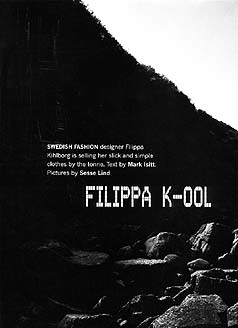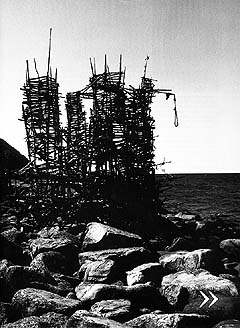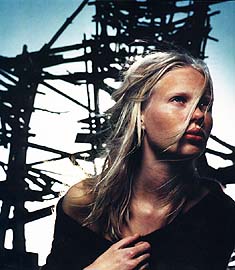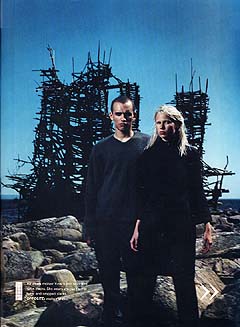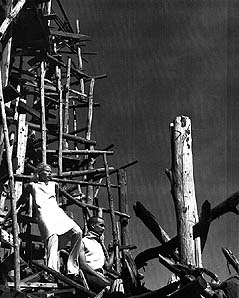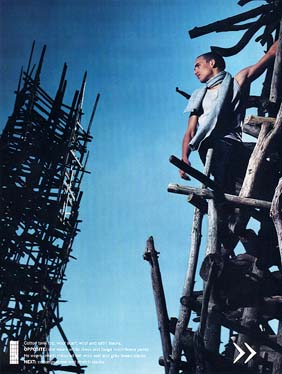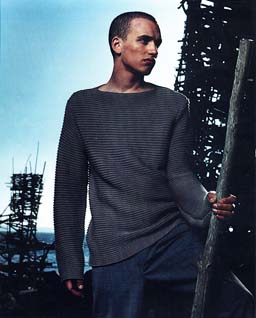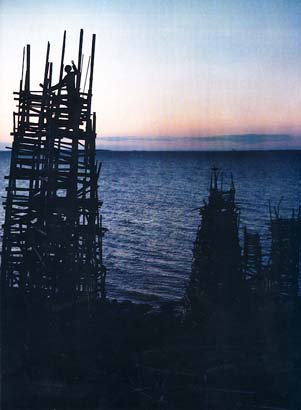 

|
Filippa K - in Ladonia
 Ladonia gets its publicity not only through court hearings or school exams. When I was flying by an SAS plane in september, I happened to read "Scanorama", the inflight magazine of SAS. There there was an interview with a dress designer Filippa Kilhborg. To my great surprise and pleasure I discovered that the setting for shooting the clothes of her was placed in... Ladonia!!! Ladonia gets its publicity not only through court hearings or school exams. When I was flying by an SAS plane in september, I happened to read "Scanorama", the inflight magazine of SAS. There there was an interview with a dress designer Filippa Kilhborg. To my great surprise and pleasure I discovered that the setting for shooting the clothes of her was placed in... Ladonia!!!
 I've scanned both the images and the interview, as well as a short presentation of Filippa K, and a presentation of Ladonia, given in the article. I've scanned both the images and the interview, as well as a short presentation of Filippa K, and a presentation of Ladonia, given in the article.
Enjoy...
Here is what was written about Ladonia:
Lure of Wasteland
 The remarkable location chosen for shooting the clothes of Filippa K is
worth an article in itself. Over the following eight pages you'll be
entering the strange world of Nimis (Latin for "too much"), a construction
made of driftwood. The remarkable location chosen for shooting the clothes of Filippa K is
worth an article in itself. Over the following eight pages you'll be
entering the strange world of Nimis (Latin for "too much"), a construction
made of driftwood.
 The artist and art historian Lars Vilks started work on Nimis in 1980. The
place chosen, the north side of the Kullaberg Nature Reserve in southern
Sweden, was so remote that he was able to work for almost, two years before
his constructions were discovered. The artist and art historian Lars Vilks started work on Nimis in 1980. The
place chosen, the north side of the Kullaberg Nature Reserve in southern
Sweden, was so remote that he was able to work for almost, two years before
his constructions were discovered.
 It didn't take long before the County Council ordered Vilks to destroy all
his objects. The claim was that they were houses and that such building was
strictly forbidden on the site. Vilks appealed, but lost. So he appealed
again, and again, until the case was finally settled by the Swedish
government. Against him. It didn't take long before the County Council ordered Vilks to destroy all
his objects. The claim was that they were houses and that such building was
strictly forbidden on the site. Vilks appealed, but lost. So he appealed
again, and again, until the case was finally settled by the Swedish
government. Against him.
 By this time, however, Christo, the artist best known for wrapping up the
German Reichstag, had caught word of Nimis and from right under the Swedish
government's nose bought the constructions (all in all 75 tonnes of
driftwood). By this time, however, Christo, the artist best known for wrapping up the
German Reichstag, had caught word of Nimis and from right under the Swedish
government's nose bought the constructions (all in all 75 tonnes of
driftwood).
 And thereby Nimis was saved from the bulldozers. Well, at least temporarily.
Yet another trial began on August 27 this year. And thereby Nimis was saved from the bulldozers. Well, at least temporarily.
Yet another trial began on August 27 this year.
 "The court cases have now become part of the art work," says Vilks. "The court cases have now become part of the art work," says Vilks.
TO GET TO NIMIS: 30km north of Helsingborg lies the Himmelstorps community
centre. From there, follow the yellow "N" signs.
www.aim.se/ladonia
|
...and a bit about...
FILIPPA KIHLBORG
 Filippa Kihlborg has design in her blood. Her parents founded Gul & BlÂ,
perhaps Sweden's most, influential chain of clothing stores ever, and her
grandfather was the architect Isak Gustaf Clason, one of Sweden's most
significant architects of his era. Filippa Kihlborg has design in her blood. Her parents founded Gul & BlÂ,
perhaps Sweden's most, influential chain of clothing stores ever, and her
grandfather was the architect Isak Gustaf Clason, one of Sweden's most
significant architects of his era.
 She was 15 when she first decided to work with clothes. She was then living
in London with her mother and brother, where she attended St Paul's Girls'
School and learnt thatl"women can do it ifs almattet of self-development,
to sharpen your intellect." She was 15 when she first decided to work with clothes. She was then living
in London with her mother and brother, where she attended St Paul's Girls'
School and learnt thatl"women can do it ifs almattet of self-development,
to sharpen your intellect."
 She returned to Sweden aged 21, to renew contact with her father, Lars
Knutsson "king of jeans", and to learn the business from the ground by
working in his Gul&Bl office in Stockholm. Six years later, in 1993,
together with two G&B colleagues - designer Karin Hellners and her husband
Patrik Kihlborg, now the MD of Filippa K - she started her now-flourishing
company. She returned to Sweden aged 21, to renew contact with her father, Lars
Knutsson "king of jeans", and to learn the business from the ground by
working in his Gul&Bl office in Stockholm. Six years later, in 1993,
together with two G&B colleagues - designer Karin Hellners and her husband
Patrik Kihlborg, now the MD of Filippa K - she started her now-flourishing
company.
|
If you are interested, here is the interview itself:
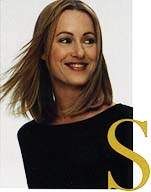 he's Filippa K. he's Filippa K.
 Yes, indeed, she is Filippa K. Yes, indeed, she is Filippa K.
 She's just as cool and sensual, just as poised and collected, as every
teenage girl who sneaks cash from her mother's purse to buy her clothes
dreams of being. She's just as cool and sensual, just as poised and collected, as every
teenage girl who sneaks cash from her mother's purse to buy her clothes
dreams of being.
 "I've got a very clear idea of what Filippa K is," she says, "and it's
probably based partly on myself. That's how it began anyway, that l wanted
something that wasn't in the shops." "I've got a very clear idea of what Filippa K is," she says, "and it's
probably based partly on myself. That's how it began anyway, that l wanted
something that wasn't in the shops."
 She's sitting behind a light grey desk, in her light grey studio, wearing a
light grey loose top and light grey slacks. And on her feet she has, er,
colourful sneakers. Yes, that's the way her clothes shouid be worn, she
says - "my simple kit ought to be combined with a whiff of personal taste".
A philosophy which has evidently gone down well at work. Of the 40 or so
employees, regardless of whether they work in the three shops (Stockholm,
Copenhagen, Oslo) or here at the headquarters in Stockholm, each and every
one of them goes around in her neutral style of uniform topped off with
eye-catching sandals or a flashy scarf. She's sitting behind a light grey desk, in her light grey studio, wearing a
light grey loose top and light grey slacks. And on her feet she has, er,
colourful sneakers. Yes, that's the way her clothes shouid be worn, she
says - "my simple kit ought to be combined with a whiff of personal taste".
A philosophy which has evidently gone down well at work. Of the 40 or so
employees, regardless of whether they work in the three shops (Stockholm,
Copenhagen, Oslo) or here at the headquarters in Stockholm, each and every
one of them goes around in her neutral style of uniform topped off with
eye-catching sandals or a flashy scarf.
 Like some businessman, you might think, who spruces up his suit with a
funny looking tie. Like some businessman, you might think, who spruces up his suit with a
funny looking tie.
 Yes, more or less. Filippa Kihlborg naturally has more style than all those
businessmen tossed together but in lots of ways she's like them. Since her
firm's modest start in 1993 it has expanded to an annual turnover of
SEK100m ($12m). Filippa Kihlborg is one of the most successful
businesswomen in Sweden. Yes, more or less. Filippa Kihlborg naturally has more style than all those
businessmen tossed together but in lots of ways she's like them. Since her
firm's modest start in 1993 it has expanded to an annual turnover of
SEK100m ($12m). Filippa Kihlborg is one of the most successful
businesswomen in Sweden.
 "We're a commercial fashion cornpany," she says matterof-factly and
crosses her arms in defiance. "We don't fancy ourselves as great artists.
We make clothes for ordinary people, clothes that we like ourselves.
Clothes that a model puts on after the show instead of during it." "We're a commercial fashion cornpany," she says matterof-factly and
crosses her arms in defiance. "We don't fancy ourselves as great artists.
We make clothes for ordinary people, clothes that we like ourselves.
Clothes that a model puts on after the show instead of during it."
 At about the time that she and her husband, the industrial designer Patrik
Kihlborg, decided to start the company they had their first child, Nina,
today five years old. Last year Tom arrived. Add to that a strong interest
in personal development and some spiritual hokus-pokus and you have a
woman who's synonymous not just with the look that almost every Swedish
city woman between 16 and 40 seems to be wearing, but with what the whole
of the nineties is taken as standing for. Filippa wants to get back to the
basies in life, she claims: back to love, companionship, contact with the
countryside and the elements. At about the time that she and her husband, the industrial designer Patrik
Kihlborg, decided to start the company they had their first child, Nina,
today five years old. Last year Tom arrived. Add to that a strong interest
in personal development and some spiritual hokus-pokus and you have a
woman who's synonymous not just with the look that almost every Swedish
city woman between 16 and 40 seems to be wearing, but with what the whole
of the nineties is taken as standing for. Filippa wants to get back to the
basies in life, she claims: back to love, companionship, contact with the
countryside and the elements.
 Just like her parents. Just like her parents.
 Mum, the designer Martina Clason, last Year bought a patch of ground in
Costa Rica in the deepest jungle surrounded by monkeys and parrots, where
she's now building her own house and giving herself time to paint. Dad,
Lars Knutsson, alias Sweden's "king of jeans", is the man who abandoned the
world of fashion and now runs an alternative training centre in the depths
of darkest Dalarna in western Sweden. Mum, the designer Martina Clason, last Year bought a patch of ground in
Costa Rica in the deepest jungle surrounded by monkeys and parrots, where
she's now building her own house and giving herself time to paint. Dad,
Lars Knutsson, alias Sweden's "king of jeans", is the man who abandoned the
world of fashion and now runs an alternative training centre in the depths
of darkest Dalarna in western Sweden.
 "It's easy to lose track of what you ought to be doing in a world which
makes so many demands on you," Filippa says. "In my case the job and the
children are a heavy load. Both infuse me with strength and energy but
leave very little space for me. And at the same time l know that everything
starts off from me. By looking after myself and getting to understand
myself l find that life is made simpler, and meeting other people gets that
much more rewarding. Whether it's marriage we're talking about or
relationships with friends and ernployees." "It's easy to lose track of what you ought to be doing in a world which
makes so many demands on you," Filippa says. "In my case the job and the
children are a heavy load. Both infuse me with strength and energy but
leave very little space for me. And at the same time l know that everything
starts off from me. By looking after myself and getting to understand
myself l find that life is made simpler, and meeting other people gets that
much more rewarding. Whether it's marriage we're talking about or
relationships with friends and ernployees."
What's your role in the company?
 "My role has shifted from being some kind of entrepeneurcum-creator to
being a leader, and that's something I wasn't prepared or trai ned for. But
I enjoy it. I'm not the typical boss type and I don't care for that kind of
leader either, but I do like getting a team to function. I take my role as
leader seriously." "My role has shifted from being some kind of entrepeneurcum-creator to
being a leader, and that's something I wasn't prepared or trai ned for. But
I enjoy it. I'm not the typical boss type and I don't care for that kind of
leader either, but I do like getting a team to function. I take my role as
leader seriously."
What's it like working at Filippa K's?
 It's a pretty liberal company. It may be the staff sometimes think the
leadership is too slack even, that we're too laid back." It's a pretty liberal company. It may be the staff sometimes think the
leadership is too slack even, that we're too laid back."
Most common problem?
 "When a firm grows as fast as we have there are a lot of communication
problems - people just don't know each other. And then you have to build up
competence; you start off with a group of young people who like clothes and
suddenly you find you need quite a different type of skill." "When a firm grows as fast as we have there are a lot of communication
problems - people just don't know each other. And then you have to build up
competence; you start off with a group of young people who like clothes and
suddenly you find you need quite a different type of skill."
How do you keep up with the trends?
 "We chat together here in the office. What would we like to have that we
can't find in the shops? That's a clear signal of what's coming, I think." "We chat together here in the office. What would we like to have that we
can't find in the shops? That's a clear signal of what's coming, I think."
Do you often think, Aha! I knew that was coming?
 "Yes, but at the same time I always have to keep thinking ahead so when
some style turns up I'm already a long way beyond it. But what I do find
myself saying now and again is God! That! How could we miss it? Or else,
perhaps I see something that I've wondered about myself but never dared to
do. Then I can be furious for being such a coward." "Yes, but at the same time I always have to keep thinking ahead so when
some style turns up I'm already a long way beyond it. But what I do find
myself saying now and again is God! That! How could we miss it? Or else,
perhaps I see something that I've wondered about myself but never dared to
do. Then I can be furious for being such a coward."
What's it like producing clothes with your own name on them?
 "One advantage with it is that it gives you greater opportunities. People
listen to you. I get a chance to present my ideas to a larger audience.
There's strength, there's power in it." "One advantage with it is that it gives you greater opportunities. People
listen to you. I get a chance to present my ideas to a larger audience.
There's strength, there's power in it."
And the disadvantage?
 "When we decided on the name I really gave it some thought, OK, am I ready
for this?, because if a piece of clothing shrinks I'm the one who gets the
blame. But at the same time that's the whole point. I stand by what I do.
It feels honest and genuine." "When we decided on the name I really gave it some thought, OK, am I ready
for this?, because if a piece of clothing shrinks I'm the one who gets the
blame. But at the same time that's the whole point. I stand by what I do.
It feels honest and genuine."
You make clothes for women and men of your own age group. When you're 60,
will Filippa K be the brand for 60-year-olds?
 "No, no! I'm already aware that I'm growing older, that I've got two
children and have reached 33 and live in upper-class Saltsj–baden [outside
Stockholm] and am beginning to acquire other values. But does that mean the
whole brand has to change? No, absolutely not, that would be to undermine
the trademark." "No, no! I'm already aware that I'm growing older, that I've got two
children and have reached 33 and live in upper-class Saltsj–baden [outside
Stockholm] and am beginning to acquire other values. But does that mean the
whole brand has to change? No, absolutely not, that would be to undermine
the trademark."
Will you carry on till you're 60, do you think?
 "Probably not. In fact, I could hop off this company today because there's
now such a clear Filippa K spirit and style. I can be talking with a new
girl on my staff and she says something like 'Oh no, that's not Filippa K.
Filippa K girls have got way more attitude than that piece of clothing.' I
can be a bit offended at first, but when I pause and think again I feel
quite flattered by it." "Probably not. In fact, I could hop off this company today because there's
now such a clear Filippa K spirit and style. I can be talking with a new
girl on my staff and she says something like 'Oh no, that's not Filippa K.
Filippa K girls have got way more attitude than that piece of clothing.' I
can be a bit offended at first, but when I pause and think again I feel
quite flattered by it."
MARK ISITT
is a former editor of SCANORAMA. He's now the editor-in-chief of
Forum, one of Scandinavia's leading magazines on design and
architecture. His most cherished garment is a corduroy suit from
Jigsaw.
SEPTEMBER 1999 SCANORAMA
And finally, the thing you've been loking for, the images from Ladonia. You can click on any image to view it in a much greater resolution.
|



 he's Filippa K.
he's Filippa K.